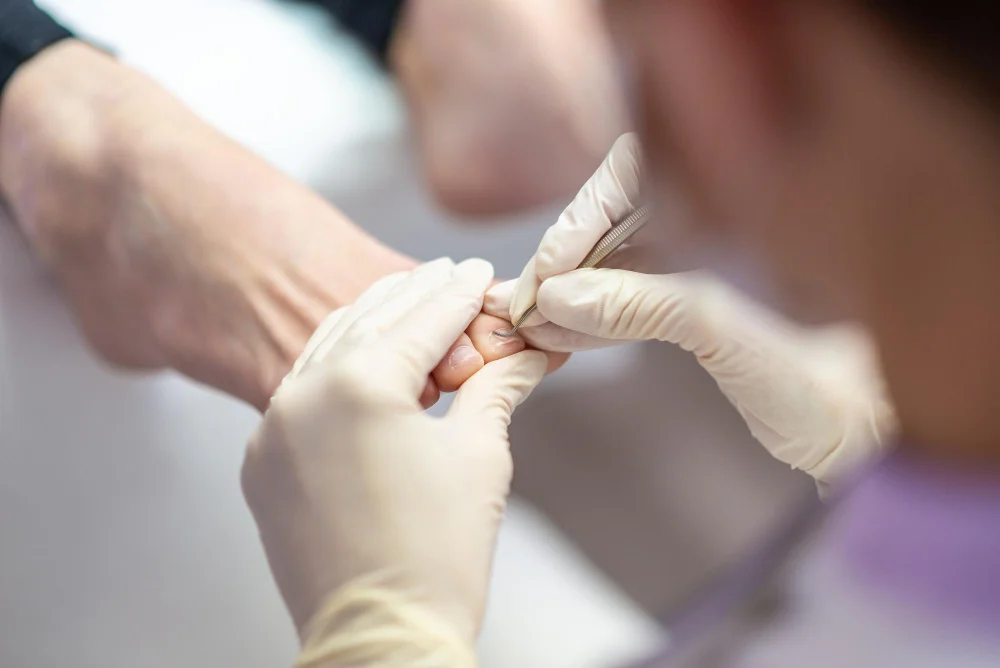Pain, irritation, and infection can result from ingrown toenails, a common foot disease. While non-invasive therapies usually work well for ingrown toenails, surgical options should be considered if the problem persists.
Conservative Treatment Options
In most cases, mild to moderate ingrown toenails can be successfully treated with conservative measures. These non-invasive treatments may include:
1. Soaking the feet
Soaking the foot in warm, soapy water regularly might help alleviate discomfort and edema by softening the skin and facilitating drainage. Soaking the foot for 15 to 20 minutes a couple of times daily is advised.
2. Proper nail trimming
Trimming the toenails straight across and avoiding excessively short nails can prevent the edges from digging into the skin. Nails should be cut regularly and not too close to the skin to reduce the risk of ingrown toenails.
3. Wearing proper footwear
Pressure on the toes can be reduced and healing facilitated by opting for shoes with plenty of room for the toes and avoiding tight, ill-fitting footwear. During recovery, wear shoes with open toes, such as sandals or flip-flops.
4. Applying topical ointments
Antibiotic ointments available over the counter are useful for avoiding infection and speeding recovery. After washing and drying the foot, these ointments might serve as an extra line of defense against infection.
When to Consider Surgery
While conservative treatments are often effective, there are situations where ingrown toenail surgery becomes a reasonable consideration. It is advisable to consult a podiatrist or foot specialist when experiencing the following conditions:
1. Chronic or severe pain
If the discomfort from an ingrown toenail continues or worsens, it may be necessary to have surgery. When other treatments have failed, surgery can get to the source of the problem and relieve chronic pain for good.
2. Recurrent infections
If you have frequent or reoccurring infections surrounding an ingrown toenail, it may be a sign that home remedies aren’t doing the trick. To avoid further infection, it may be essential to remove the ingrown section of the nail surgically.
3. Impaired mobility or activity restriction
Surgical correction may be necessary when the ingrown toenail hinders normal walking or participation in physical activities. Surgery can help restore mobility and enable individuals to engage in daily activities without discomfort or limitations.
4. Presence of abscess or drainage
If an ingrown toenail leads to the formation of an abscess or significant drainage, surgical intervention may be required. Surgery can involve removing the infected tissue, addressing the underlying cause, and promoting proper healing to prevent further complications.
Types of Ingrown Toenail Surgery
When surgery is deemed necessary, there are a few different approaches that a podiatrist may consider, depending on the severity of the condition:
1. Partial nail avulsion
Ingrown toenail surgery is the most typical treatment option. The ingrown edge and a small section of the nail are surgically removed, but the rest is left unharmed. To prevent the ingrown part from growing back, a chemical or electrical approach may be utilized during the treatment, usually done under local anesthetic. Minimal pain and speedy healing are typical after a partial nail avulsion.
2. Total nail avulsion
In more severe situations or when there is a considerable chance of recurrence, it may be recommended to remove the entire nail. The nail and nail bed are both eliminated during this treatment. Local anesthetic is used, and sutures may be necessary.
Total nail avulsion is sometimes used to treat ingrown toenails that have persisted after other treatments and is sometimes followed with nail matrix ablation to prevent regrowth. Nail avulsions can be divided into two categories: total and partial.
Recovery and Post-Surgical Care
Following ingrown toenail surgery, proper post-operative care is crucial for optimal healing and to reduce the risk of complications. The podiatrist will provide specific instructions, which may include:
1. Keeping the foot clean and dry
Good foot hygiene is especially important after having surgery to remove an ingrown toenail. Infections can be avoided, or at least kept to a minimum, if the surgical site is kept clean and dry. Heeding the podiatrist’s advice on keeping the area dry and clean is essential for a speedy recovery.
2. Taking prescribed medications
The podiatrist may prescribe antibiotics to prevent infection and pain relievers to ease discomfort during recovery. To promote optimum recovery, taking these drugs as prescribed and finishing the entire course of antibiotics is crucial.
3. Wearing appropriate footwear
It is crucial to wear supportive footwear after surgery. Wearing shoes with a wider toe box or a looser fit can help alleviate pain and speed up the healing of a stubbed toe. Shoes that are too snug or restrictive should be avoided during the healing process to avoid unnecessary pain or consequences.
4. Following up with the podiatrist
The healing process can be monitored, and any issues can be addressed at regular follow-up visits with your podiatrist. The podiatrist will check in to see how things are doing, remove sutures if required, and offer advice on moving forward with activities, wound care, and resuming regular footwear and exercise.
Know When You Should Have A Toenail Surgery
Most cases of ingrown toenails respond well to non-invasive treatments, but occasionally surgical removal is required.
By seeing a podiatrist, patients can get professional guidance and decide on the best course of treatment. Prompt treatment and attention are essential to reduce pain, avoid complications, and restore full foot health.


















